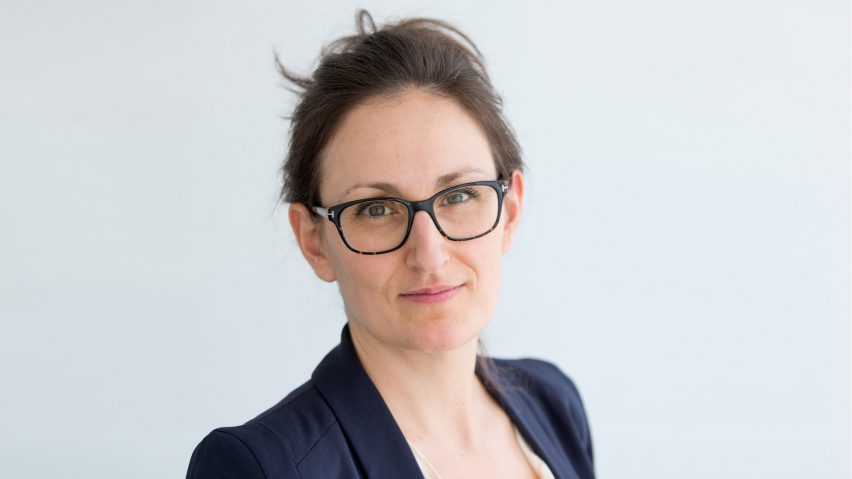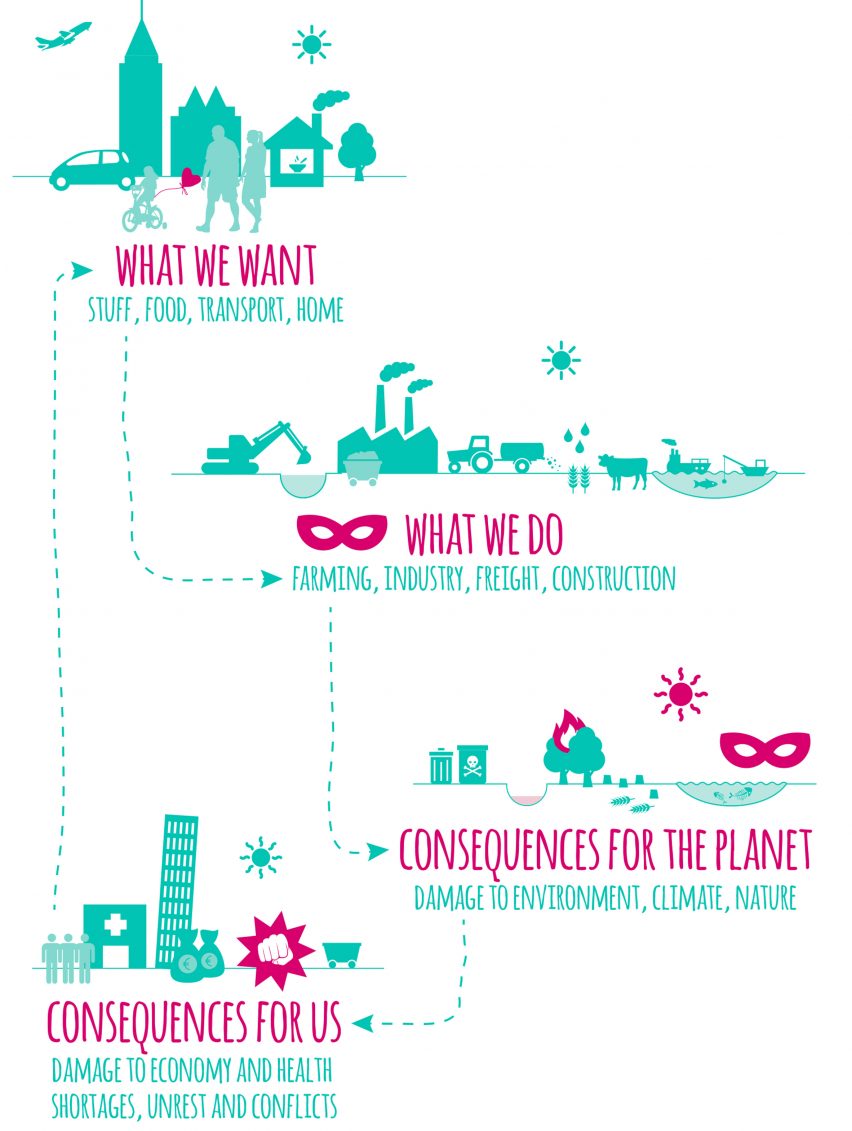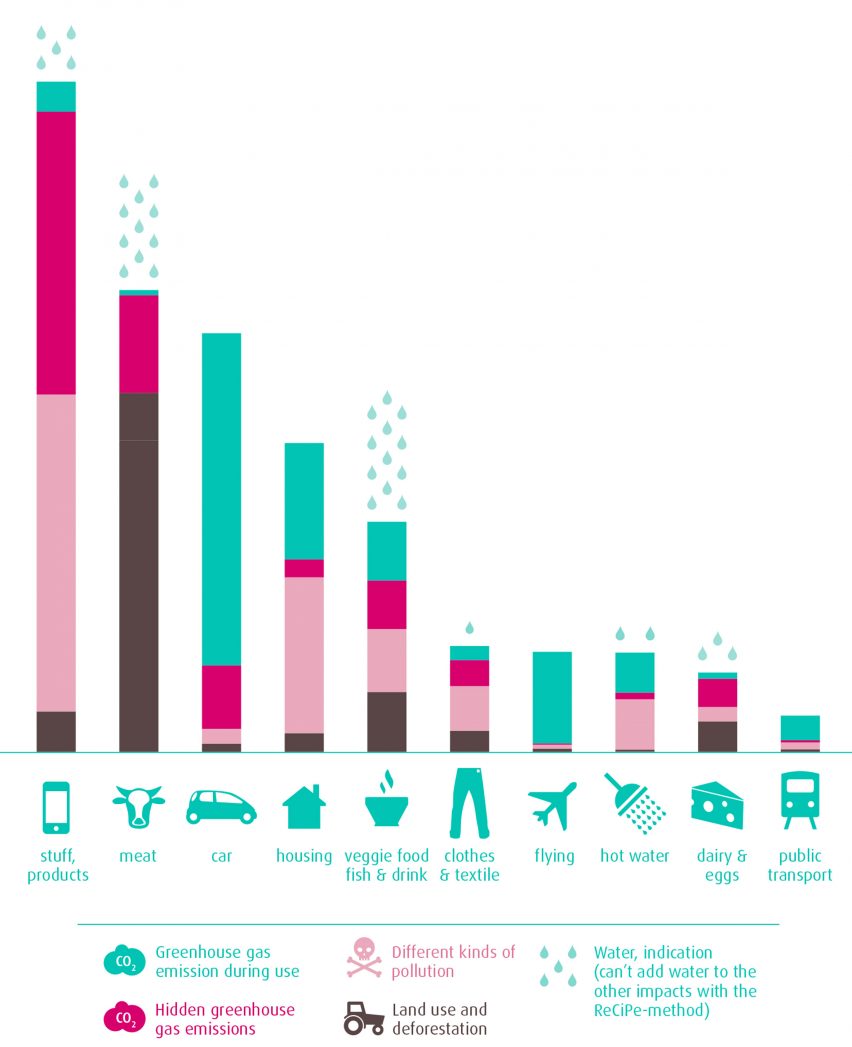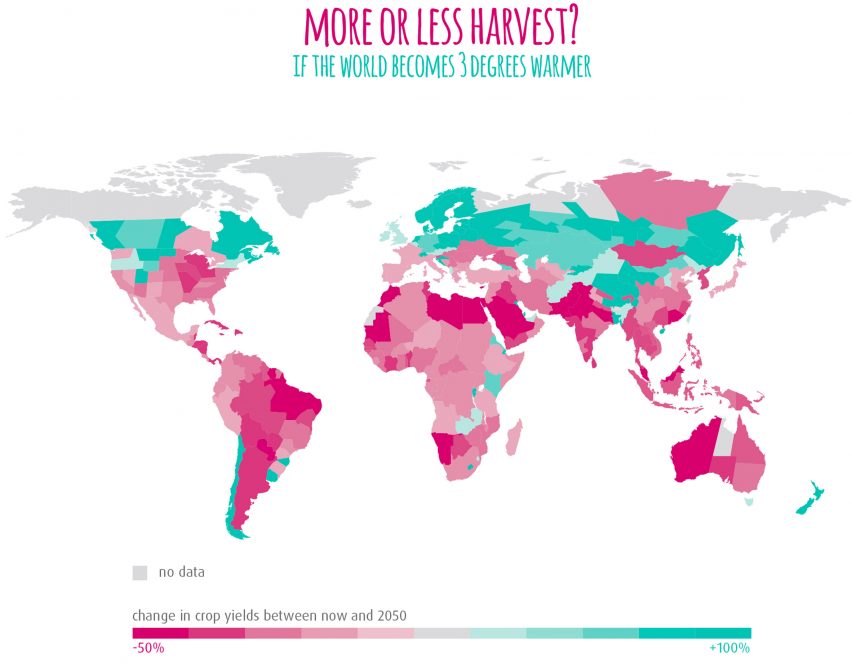
We need designers, not scientists, to show us how to change the world, says Babette Porcelijn
Designers have the power to solve the world's problems, but it may mean creating more systems and less stuff, says Dutch designer and environmentalist Babette Porcelijn.
According to Porcelijn, designers are better equipped than any other profession to offer solutions to issues such as pollution, climate change and depletion of resources.
"Scientists can show us what we should not do, but we need designers to show us what we should do," she told Dezeen.
"It requires a paradigm shift – you have to rethink everything. It's a design issue and a design challenge."
But she believes solutions can only be reached if designers start thinking about the bigger picture, rather than focusing on only one issue at a time.
"You have to think about all things combined," she said. "If you focus on one single issue, you might just fix it, but you might make things worse in another area."

Porcelijn trained as an industrial designer, but recently authored a book titled De Verborgen Impact (Hidden Impact), which reveals the full extent to which human actions affect the planet, including the things analysts don't often account for.
She presented her findings during Dezeen's Good Design for a Bad World talk series at Dutch Design Week. The biggest human impact on the planet, she explained in the talk, is the manufacture of new products.
"I never expected that products would be the number one impact on the world," the designer told Dezeen, following the talk.
"It's really surprising. I thought it would be flying or meat. But that's the point – you don't know and you can't trust your intuition when it comes to the environment, because the blind spot of hidden impact is so big that our gut feeling is often not correct."

Porcelijn is now calling for designers to completely rethink their approach. She believes design skills could, for instance, be better applied to developing sustainable new supply chains or solving the global food crisis.
"I think we all need to get our priorities straight," she said. "Prior one is not your own design status or the money you make. All those things are inconsequential if there is no proper society functioning anymore!"
"Now is the time to make the right designs, and perhaps that means not designing something," she continued. "It could mean designing an immaterial solution, to help people to not want to have a crazy abundance of stuff they don't really need. It could be to design food that is sustainable but just as nice as the food we eat now. It could be to design a power supply that is sustainable and functions just as well as the ones we have now."
"We have to do all these things if we want to save our society."
Porcelijn was one of four speakers in the Good Design for a Bad World talk focused on climate change, which took place in Eindhoven on 21 October 2017.
This and the four other talks were livestreamed via the Dezeen Facebook page, and can all available to watch in full. An edited version of the talk is also available.
Read on for the full transcript of the interview:
Amy Frearson: Can you tell me how and why you got started on this project?
Babette Porcelijn: I started in the beginning of 2014. I was at home with my husband, and he showed me some graphics produced by the Club of Rome. The Club of Rome is a group of scientists working together to try and predict the future. They predict that, by 2030, the whole system may collapse because all the problems have become so huge that the system will fail.
My husband said, did you know that the 16 biggest sea container ships in the world are just as polluting as all the cars combined? And there aren't just 16 of those things, there are 50,000 travelling the world 24/7. And what they do is they bring products, stuff to our shops, and grain to our bakeries and coal to our power plants, so that we can buy everything, eat cookies, plug in our phones.
He made a calculation that every day we lose 27 million trees more than we plant. I was so surprised about that. He told me that deforestation is not just a problem because of CO2 balance – obviously trees need to absorb CO2 and they can't do that anymore – but also because of the biodiversity in forests, they hold the fertile soil. So if you deforest the landscape, fertile soil may wash away and you can't regrow it. It's often an irreversible process.
Also, where there is forest there is rain. One tree produces about 5,000 litres of water per day, through clouds. If you take trees away, it will become dry in the area. So forest is so important.
Did you know that the 16 biggest sea container ships in the world are just as polluting as all the cars combined?
I asked him, if forests are so important for everything, why would you ever fell a tree? He said, in many cases, it's to make way for soy plantations. To make fodder for cattle. So, in the end, it's for the meat on our plate.
All of this made me realise things were so much worse than I had thought. And it's directly linked to our consumerism and the way we live. We are way more responsible than we want to know. We live in a bubble and I want to look outside that bubble.
In that moment, it was if I had been struck by lightening. I said, I'm going to start a project and I don't know where it ends, but I'm going to do something – it's too important to leave it. And in the end I wrote a book and I never stopped again.

Amy Frearson: So the book is about identifying all the things that cause problems for the world, and showing how they compare to one another?
Babette Porcelijn: Yes, because as a designer, you try to get a grip on the whole problem and not just the parts. And then of course, as a designer, you want to solve the problem – that's what we do. So I'm looking for the most effective ways to solve these problems.
I took in a much broader perspective than most environmentalists would ever do. I was told when I was writing this book that it was too broad, but I said I was going to do it anyway, because we have to know how these things work, so that we can make the problem actionable.
We don't have the time to spoil, wasting our energy on things that don't really matter
The other people on the panel [for the Good Design for a Bad World talk] said you have to keep it small, because you can't change the world. But I don't agree – you can change the world, if you know what the big things are and make them actionable. Otherwise you might waste your energy on things that don't really matter. And we don't have the time to spoil, wasting our energy on things that don't really matter. We have to be very effective in the way we solve our problems.
Amy Frearson: So, for issues such as climate change, what can designers do to make things actionable and make a real difference?
Babette Porcelijn: First of all, you can't think just think about climate change, you have to think about all things combined. If you focus on one single issue, you might just fix it, but you might make things worse in another area.
For instance, if we want to stop using fossil fuels, which of course we do, but we then can use biomass because that's CO2-neutral. But it's not eco-neutral because if we use biomass to feed our power plants, we need all this land to grow biomass and there's no space left for agriculture. So you have to look at the whole system and then come up with solutions.
Amy Frearson: Designers usually approach one problem at a time. But you're saying these problems require us to think bigger?
Babette Porcelijn: They do. And I think, if one profession can do it, it should be designers. To look at the whole system and think big, then identify what you can do that is effective, then bring it down to something that you can actually do. Even if its small, make sure it's as effective as possible.
Amy Frearson: Can you give any examples?
Babette Porcelijn: There are all kinds of philosophical systems of thinking. But a really easy example for individuals is: you can do things better, different or less. Three lines of thinking.
If you take beef, for example, which has the biggest impact of any meat. A better piece of meat would be chicken – it has less impact. Something different would be a vegetarian burger. And less is obviously smaller portions and not as often.
These lines of thought can help you come up with ideas and changes.

Amy Frearson: Can you tell me some of the most surprising findings from your research?
Babette Porcelijn: I fell off my chair a couple of times! First of all, I never expected that products would be the number one impact on the world. It's really surprising. I thought it would be flying or meat. But that's the point – you don't know and you can't trust your intuition when it comes to the environment, because the blind spot of hidden impact is so big that our gut feeling is often not correct. And that's what I ran into all the time. If you really dive into it then you uncover what the real big things are.
I was really surprised when I found out the main source of microplastics/microbeads. I really thought it would be hair shampoo or toothpaste. But they are nothing compared to tyre wear from cars. Driving a car for just one kilometre, you emit more microbeads than you do in a year in your bathroom. That was really surprising to me.
Amy Frearson: For those who don't know what microbeads are and how they contribute to pollution, can you give a brief explanation?
Babette Porcelijn: Microbeads go into water, into the oceans. They are plastic soup.
Amy Frearson: They contribute to ocean plastic?
Babette Porcelijn: Yes, but they are not just harmful in the sea. They are also harmful in the soil and in the air. When plastic is in the soil it might be getting into our food system, we don't know, but we do know that animals eat it. Worms eat it and birds eat worms so it gets inside the birds. We don't have any idea of the consequences of this. But we do now that it's everywhere.
To close the loops we have to start working together with the whole production chain, not just one supplier
Amy Frearson: What are the best systems to tackle these types of problems? Should we be promoting more closed-loop systems, or simply reducing our consumption? Or do we need to develop more complex systems?
Babette Porcelijn: We have to do all of those things – reducing our use drastically and also closing the loops. And in order to close the loops we have to start working together with the whole production chain, not just one supplier.
Usually we just look one supplier down the line and then we buy sustainable stuff and think we are doing the right thing. But if you really close the loop then you see the whole supply chain work together and make that circular. It's a totally different way of thinking and operating, and its also a design challenge to come up with product and material and business models which allow for supply chains to be closed. It's way different to how we work now.

Amy Frearson: In design, people often seem to be obsessed with originality – so if one designer adopts a certain sustainable approach, or works with a particular recycled material, other designers are put off doing the same thing. Is this a problem you've picked up on?
Babette Porcelijn: I think we all need to get our priorities straight. Prior one is not your own design status or the money you make. All those things are inconsequential if there is no proper society functioning anymore! That sounds dramatic, but if we continue like this, we are facing a non-functioning economy. Then you're there with your beautiful designs but it doesn't matter anymore.
Our priority number one should be to keep the planet and our society safe.
Now is the time to make the right designs, and perhaps that means not designing something. It could mean designing an immaterial solution, to help people to not want to have a crazy abundance of stuff they don't really need. It could be to design food that is sustainable but just as nice as the food we eat now. It could be to design a power supply that is sustainable and functions just as well as the ones we have now. And to help corporations do it and help the industry do it and to help the government with ways to stimulate us. We have to do all these things if we want to save our society.
What I want to know is what the world will look like in 2050 if we start doing the right thing now
If you don't want to then that's your choice, it's not up to me, but if you do want to then I can help to show you the most effective way. And if I don't have the answers, because I don't have all the answers, I can at least make sure that you ask the right questions before you start.
Amy Frearson: Now that the book is published, what are your next steps for this project?
Babette Porcelijn: What I want to know is what the world will look like in 2050 if we start doing the right thing now. It puts a dot on the horizon and I hope it inspires people and helps to align our goals.
Scientists can show us what we should not do, but we need designers to show us what we should do. It requires a paradigm shift – you have to rethink everything. It's a design issue and a design challenge. I think it's cool.
Do you know Joseph Campbell's model for how you find your bliss? It's comprised of four circles and where they overlap, that's where your bliss is. One circle is what the world needs, the second is what the world will pay for, the third is what you love to do and the fourth is what you're good at. To find your bliss, you need a mix of those four things.
I think I have found mine and that makes me so happy. I can only imagine it works like that for more people. So for young designers wanting to save the world, find your way to do it in a way that you like, and in a way that the world will pay for. Otherwise it's not going to be as effective.
